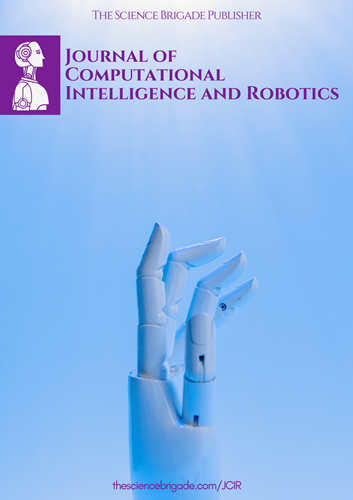Multi Robot Systems - Coordination and Communication: Exploring Coordination and Communication Mechanisms in Multi Robot Systems to Achieve Collaborative Tasks Efficiently
Keywords:
Multi-robot systems, coordination, communication, centralized, decentralized, distributed, artificial intelligence, machine learning, bandwidth, latencyAbstract
Multi-robot systems (MRS) have gained significant attention for their potential to accomplish complex tasks efficiently and robustly. Coordination and communication are key aspects in ensuring the successful operation of such systems. This paper provides a comprehensive review of the existing literature on coordination and communication mechanisms in MRS. We discuss various approaches, including centralized, decentralized, and distributed methods, highlighting their strengths and limitations. Additionally, we explore the role of communication in enabling effective coordination among robots, considering factors such as bandwidth, latency, and reliability. Furthermore, we examine emerging trends and future directions in MRS coordination and communication, including the integration of artificial intelligence and machine learning techniques. Overall, this paper aims to provide insights into the state-of-the-art in MRS coordination and communication, offering guidance for researchers and practitioners in the field.
References
Pargaonkar, Shravan. "A Review of Software Quality Models: A Comprehensive Analysis." Journal of Science & Technology 1.1 (2020): 40-53.
Raparthi, Mohan, Sarath Babu Dodda, and SriHari Maruthi. "Examining the use of Artificial Intelligence to Enhance Security Measures in Computer Hardware, including the Detection of Hardware-based Vulnerabilities and Attacks." European Economic Letters (EEL) 10.1 (2020).
Pargaonkar, Shravan. "Bridging the Gap: Methodological Insights from Cognitive Science for Enhanced Requirement Gathering." Journal of Science & Technology 1.1 (2020): 61-66.
Vyas, Bhuman. "Ensuring Data Quality and Consistency in AI Systems through Kafka-Based Data Governance." Eduzone: International Peer Reviewed/Refereed Multidisciplinary Journal 10.1 (2021): 59-62.
Rajendran, Rajashree Manjulalayam. "Scalability and Distributed Computing in NET for Large-Scale AI Workloads." Eduzone: International Peer Reviewed/Refereed Multidisciplinary Journal 10.2 (2021): 136-141.
Pargaonkar, Shravan. "Future Directions and Concluding Remarks Navigating the Horizon of Software Quality Engineering." Journal of Science & Technology 1.1 (2020): 67-81.
Raparthi, M., Dodda, S. B., & Maruthi, S. (2020). Examining the use of Artificial Intelligence to Enhance Security Measures in Computer Hardware, including the Detection of Hardware-based Vulnerabilities and Attacks. European Economic Letters (EEL), 10(1).
Pargaonkar, S. (2020). A Review of Software Quality Models: A Comprehensive Analysis. Journal of Science & Technology, 1(1), 40-53.
Vyas, B. (2021). Ensuring Data Quality and Consistency in AI Systems through Kafka-Based Data Governance. Eduzone: International Peer Reviewed/Refereed Multidisciplinary Journal, 10(1), 59-62.
Pargaonkar, S. (2020). Bridging the Gap: Methodological Insights from Cognitive Science for Enhanced Requirement Gathering. Journal of Science & Technology, 1(1), 61-66.
Rajendran, R. M. (2021). Scalability and Distributed Computing in NET for Large-Scale AI Workloads. Eduzone: International Peer Reviewed/Refereed Multidisciplinary Journal, 10(2), 136-141.
Pargaonkar, S. (2020). Future Directions and Concluding Remarks Navigating the Horizon of Software Quality Engineering. Journal of Science & Technology, 1(1), 67-81.
Downloads
Published
How to Cite
Issue
Section
License

This work is licensed under a Creative Commons Attribution-NonCommercial-ShareAlike 4.0 International License.
License Terms
Ownership and Licensing:
Authors of this research paper submitted to the journal owned and operated by The Science Brigade Group retain the copyright of their work while granting the journal certain rights. Authors maintain ownership of the copyright and have granted the journal a right of first publication. Simultaneously, authors agreed to license their research papers under the Creative Commons Attribution-NonCommercial-ShareAlike 4.0 International (CC BY-NC-SA 4.0) License.
License Permissions:
Under the CC BY-NC-SA 4.0 License, others are permitted to share and adapt the work, as long as proper attribution is given to the authors and acknowledgement is made of the initial publication in the Journal. This license allows for the broad dissemination and utilization of research papers.
Additional Distribution Arrangements:
Authors are free to enter into separate contractual arrangements for the non-exclusive distribution of the journal's published version of the work. This may include posting the work to institutional repositories, publishing it in journals or books, or other forms of dissemination. In such cases, authors are requested to acknowledge the initial publication of the work in this Journal.
Online Posting:
Authors are encouraged to share their work online, including in institutional repositories, disciplinary repositories, or on their personal websites. This permission applies both prior to and during the submission process to the Journal. Online sharing enhances the visibility and accessibility of the research papers.
Responsibility and Liability:
Authors are responsible for ensuring that their research papers do not infringe upon the copyright, privacy, or other rights of any third party. The Science Brigade Publishers disclaim any liability or responsibility for any copyright infringement or violation of third-party rights in the research papers.




